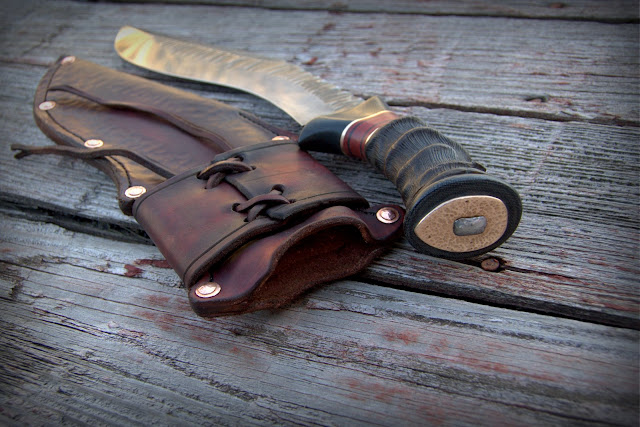Tomahawk Iron John Logan made for a traditional woodcarver in the Tlingit (Totem Pole) area of Alaska. The overall design is inspired by historical tomahawks of the Mississippian style of the southern plains, though the customer designed the carved engravings I did around the eye in the Tlingit style.
I hand forged this of 1050 carbon steel with Swedish Silver steel cutting edge. Hammer poll and traditional diamond shaped eye. Handle of flame curly Hickory with bands of hot checkering and traditional Aquafortis stain. Walnut dyed sheep leather quirt completes the piece.
I started with the customer's own sketch. As an artist himself, he knew what he wanted and could convey that to me on paper. As a woodcarver he wanted a tool that he could use while camping and in his work, but he wanted it as traditional as possible. As he already has many pieces in the style of his native Alaska, he wanted something from another American region - we both agreed that the Mississippian style is not commonly seen in todays makers, so would make a truly one of a kind piece.
I started forging the tomahawk head from a pieces of 1inch x 1-1/2inch bar of 1050 steel. Mississippian tomahawks often have a diamond shaped eye, which I had not done before so I had to make a new drift tool to shape this area, and as he wanted this to be purely a tool I forged it solid, rather then traditionally the back of the head would have been a tobacco pipe in this case it is a hammer. 1050 steel is a great choice for hammers and axes as it is tough and will not bend, but will not get hard enough to support a good cutting edge. Like tomahawks of old, I added a high carbon steel bit to the edge by chiseling a slot in the bit and forge welding a sliver of blade steel into the slot. I choose Swedish Silver steel (this is the alloy name, as it is not made in America it does not have an AISI alloy number, though it is similar to our W-2 with added Chromium) for its high regard within the wood carving community for it's edge holding ability.
After forging the tomahawk head is rough ground and the details refined. The second image really shows the diamond cross section of the eye. Today we mostly see what is termed the teardrop eye in tomahawks, though historically there were many different eye shapes. Teardrop eyes come from wrapped-eye trade tomahawks which have a totally different construction method then pipe tomahawks. I have yet to see an original pipe tomahawk with a teardrop eye, so it was exciting to forge one with a much more traditional cross section!
The tomahawk head is finished with hand filing. I have tried over the years to streamline this final process, but nothing but hand files and a lot of elbow grease does it justice.


As I mentioned above the customer is a traditional woodcarver in the Native Tlingit style of Alaska, together we thought it would be cool to make this tomahawk a collaboration to highlight each other's work. He designed the traditional North West Coast motifs for the panels around the eye of the tomahawk, and I carved them into the steel with hand engraving.
With the tomahawk head now complete I turned to the handle.
The customer wanted the handle to be made of good strong Hickory for longevity of use, though liked the idea of curly figure as is often seen on fancy tomahawks. Curly figure is most often thought about as a trait of the Maple tree, but any tree that gets old enough will do it. It is literally where the tree gets old enough and large enough that as it tries to continue to grow upwards it can not push itself skywards, and thus the grain wrinkles. Weaker woods such as Maple and Walnut are famous for this beautiful wrinkled ie "curly" figure, with many sub-categories such as Flame, Quilted, Fiddle-back, Tigger-strip, etc to describe the nuances of the grain. Stronger woods such as Hickory have to get really old and heavy for this to happen, and thus is not all that common in lumber - But after a lot of searching the internet I did find a beautiful pieces of Flame curly Hickory.
Tomahawk handles traditionally are often ornately decorated with inlays and carvings and other traditional art forms, though again as the customer wanted this to be primarily as a tool, so I wanted to keep the grain and thus the strength of the handle as intact as possible. I choose a traditional technique called "hot checkering" to texture bands around the handle. This technique uses a red hot rasp or file to burn imprints of it's teeth into the wood. Once polished back it looks very similar to the checkering seen on high end firearms.
Last but not least I used a historical alchemical stain to bring out the figure of the wood and to give it a deep rich color. Aquafortis, Latin for "loud water" is a mix of Nitric and Muradic acids and iron, when applied to wood and heated it does two things; first it eats away at the microscopic fibers between the grain allowing light to refract off of and show the figure better, it also caramelizes the natural sugars in the wood staining it dark.

















































